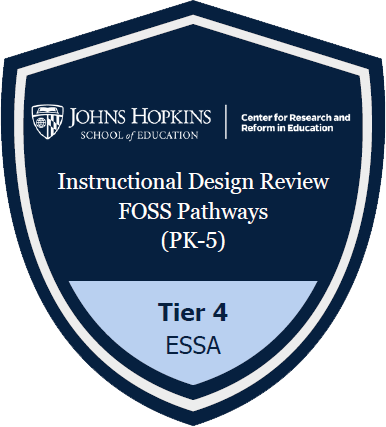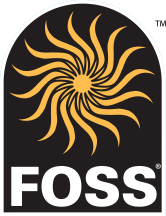FOSS Pathways
Today as never before, the world needs scientific thinkers to view the world thoughtfully, approach challenges analytically, and embrace opportunities enthusiastically.
FOSS®, a longtime leader in science education, has stepped forward to meet that challenge with the newly streamlined FOSS Pathways™. Pathways is a phenomena-based hands-on science curriculum that was designed to provide teachers with everything they need to meet standards in the time they have allotted to teach science.
Pathways Awarded Gold Medal Parent and Teacher Choice Award

Discover the Award-Winning FOSS Pathways Science Resources Student Books.
Pathways Awarded ESSA Tier 4 by Johns Hopkins School of Education

Listen to our Podcast to discover all the ways FOSS curriculum meets the criteria.
Discover how Pathways:
Addresses limited time for science instruction: Grades K-2 includes 60 sessions and Grades 3-5 includes 90 sessions per school year.
Includes editable Teaching Slide decks in Google Slides and PowerPoint. Slides can be translated into any language offered with Google translate.
“I know (with) the FOSS science lessons… there is no last-minute scramble for materials. Everything is provided and in good condition. My students love FOSS and so do I!”
LYDIA L. – TEACHER, UTAH

Offers improved online assessment for grades 3-8 that can be translated into any language offered with Google translate.
Aligns to national science standards using three-dimensional teaching, learning, and assessment.
“FOSS is fun! Everything is in the modules. This saves a lot time because the teacher is not running around trying to find all the materials. Every teacher has an “AHA” moment and FOSS is mine! Thank you FOSS for making teaching science fun!“
LASHON B. – MS SCIENCE TEACHER, MISSISSIPPI

Integrates English Language Arts to support student literacy and the science of reading.
Utilizes a multimodal approach to resonate with every student.
Lends flexibility to teach in the class time allotted for science.
Immerses students in figuring out local and relevant phenomena and engineering problems.
Provides unmatched teacher support to teach phenomena-based science.
Provides Side Trip opportunities to customize instruction and expand learning opportunities.
“The pathway of instruction is so clear. Students are invested in figuring out phenomena or solving a problem with intentional explorations. The pathway of instruction is easy to follow with multiple access points for students to be successful.”
KATRINA H. – STEAM COORDINATOR, NEVADA
See FOSS Pathways in action and get a glimpse of its power.
Recommended Scope & Sequence
FOSS Pathways™ PK-5 aligns to national science standards using three-dimensional teaching, learning, and assessment.
FOSS has evolved over time to meet the changing science education landscape and is aligned to the Next Generation Science Standards (NGSS). In our Scope and Sequence Chart below you will see how FOSS is aligned to NGSS Performance Expectations for each module.
FOSS Pathways PreK-5

Grade
Earth Science
Physical Science
Life Science
PK
Foundation for LS1.A, LS1.C, PS1.A, ESS3.C
K
K-LS1-1 | K-ESS2-1 | K-ESS2-2 | K-ESS3-1 | K-ESS3-2 | K-PS3-1
K-PS2-1 | K-PS2-2 | K-PS3-1 | K-PS3-2 | K-ESS3-3 | K-2-ETS1-1 | K-2-ETS1-2 | K-2-ETS1-3
K-LS1-1 | K-ESS2-2 | K-ESS3-1
1
1-ESS1-1 | 1-ESS1-2
1-PS4-1 | 1-PS4-2 | 1-PS4-3 | 1-PS4-4 | K-2-ETS1-1 | K-2 ETS1-2 | K-2-ETS1-3
1-LS1-1 | 1-LS1-2 | 1-LS3-1 | K-2-ETS1-2
2
2-ESS1-1 | 2-ESS2-1 | 2-ESS2-2 | 2-ESS2-3 | 2-PS1-1
2-PS1-1 | 2-PS1-2 | 2-PS1-3 | 2-PS1-4 | K-2-ETS1-1 | K-2-ETS1-2 | K-2-ETS1-3
2-LS2-1 | 2-LS2-2 | 2-LS4-1 | K-2-ETS1-2
3
3-ESS2-1 | 3-ESS2-2 | 3-ESS3-1
3-PS2-1 | 3-PS2-2 | 3-PS2-3 | 3-PS2-4 | 3-5-ETS1-1 | 3-5-ETS1-2 | 3-5-ETS1-3
3-LS1-1 | 3-LS2-1 | 3-LS3-1 | 3-LS3-2 | 3-LS4-1 | 3-LS4-2 | 3-LS4-3 | 3-LS4-4
4
4-ESS1-1 | 4-ESS2-1 | 4-ESS2-2 | 4-ESS3-2 | 3-5-ETS1-2
4-PS3-1 | 4-PS3-2 | 4-PS3-3 | 4-PS3-4 | 4-PS4-1 | 4-PS4-2 | 4-PS4-3 | 4-ESS3-1 | 3-5-ETS1-1 | 3-5-ETS1-2 | 3-5-ETS1-3
4-LS1-1 | 4-LS1-2 | 3-5-ETS1-1
5
5-ESS1-1 | 5-ESS1-2 | 5-ESS2-1 | 5-ESS2-2 | 5-ESS3-1 | 5-PS1-1 | 5-PS2-1 | 3-5-ETS1-1 | 3-5-ETS1-2
5-PS1-1 | 5-PS1-2 | 5-PS1-3 | 5-PS1-4 | 5-ESS3-1 | 3-5-ETS1-2
5-PS3-1 | 5-LS1-1 | 5-LS2-1 | 5-ESS2-1 | 5-ESS3-1 | 3-5-ETS1-3
Engage Young Minds: Explore Our Top Picks for Nonfiction Readers That Bring Science to Life
Explore our curated collection of nonfiction science readers, perfectly tailored for learners in grades K-5. These engaging readers, published by School Specialty® and Delta Education®, transform scientific concepts into captivating narratives, sparking curiosity and fostering a love for discovery. Designed with the Next Generation Science Standards (NGSS) in mind, our readers seamlessly integrate with your science curriculum while simultaneously supporting the Science of Reading. Through captivating content and vibrant visuals, students will not only gain a solid foundation in key scientific principles but also develop informational text-reading skills, expand their scientific vocabulary, and deepen their understanding of the world around them.
Grade
Earth Science
Physical Science
Life Science
K
3
4
ScienceFLEX Leveled Readers
Delta Science Content Readers
Delta Science Readers
Delta Science First Readers
Delta Explore Primary Leveled Readers

